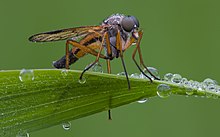Rhagionidae
| Rhagionidae | |
|---|---|

| |
| Rhagio scolopaceus | |
| Scientific classification | |
| Kingdom: | |
| Phylum: | |
| Class: | |
| Order: | |
| Suborder: | |
| Infraorder: | |
| Superfamily: | |
| Family: | Rhagionidae
|
| Subfamilies [1] | |
| |
Rhagionidae or snipe flies are a small family of flies.
Description
Rhagionidae are medium-sized or large flies with slender bodies and stilt-like legs. The mouthparts are adapted for piercing and many species are haematophagous as adults, while others are predatory on other insects. They are typically brown and yellow flies, and lack bristles. The larvae are also predatory and are mostly terrestrial, although some are aquatic .[2]
Snipe flies in the genus Rhagio are sometimes called "down-looker" flies after their habit of perching head-downward on tree trunks.
Classification

"down-looker fly"

The family is contained in Brachycera infraorder Tabanomorpha, and several of its constituent groups have been recently elevated to family rank. Atherix (and related genera) now comprise the Athericidae, Vermileo (and related genera) now comprise the Vermileonidae, and the genera Austroleptis and Bolbomyia are each now the sole members of their own families (Austroleptidae and Bolbomyiidae). The subfamily Spaniinae was sometimes accorded family rank, but this is not accepted in the most recent revisionary classification.[3]

exhibiting its "down-looker" behaviour
List of genera
- Alloleptis Nagotomi & Saigusa in Nagatomi, 1982 - Sulawesi
- Arthroceras Williston, 1886 - Nearctic, Palearctic
- Arthroteles Bezzi, 1926 - Afrotropic
- Atherimorpha White, 1914 - Australasia, Neotropic, Afrotropic
- Chrysopilus Macquart, 1826 - Nearctic, Palearctic, Afrotropic, Neotropic, Oriental
- Desmomyia Brunetti, 1912 - Palearctic, Oriental
- Litoleptis Chillcott, 1963 - Nearctic, Oriental, Neotropic
- Omphalophora Becker, 1900 - Palearctic, Nearctic
- Ptiolina Staeger in Zetterstedt, 1842 - Nearctic, Palearctic
- Rhagio Fabricius, 1775 - Nearctic, Palearctic
- Schizella Bezzi, 1926 - Philippines
- Sierramyia Kerr, 2010 - Nearctic/Neotropic
- Spania Meigen, 1830 - Nearctic, Palearctic
- Spaniopsis Senior-White, 1914 - Australasia
- Stylospania Frey, 1954 - Philippines
- Symphoromyia Frauenfeld, 1867 - Nearctic, Palearctic
See also
Footnotes
References
- L. Watson and M. J. Dallwitz (2007-04-09). "Rhagionidae". British Insects: the Families of Diptera.
- "Rhagionidae". Fauna Europaea. Retrieved 2007-07-02.
- "Nomina — Diptera: P–S". Nearctica. 1998.
- "A Check List of Japanese Insects".
Further reading
- Bezzi, M. 1928. Diptera Brachycera and Athericera of the Fiji Islands based on material in the British Museum (Natural History). British Museum (Natural History), London. viii + 220 pp.
- Lindner, E 1924–1925. Rhagionidae in Die Fliegen der Paläarktischen Region 4 (20) 1–49. ISBN 3-510-43016-6 Keys to genera and species.
- Stuckenberg, B., 1960. Diptera (Brachycera): Rhagionidae. S.Afr. anim. Life 7: 216–308 Keys to genera and species.
- Stuckenberg, B., 1965. The Rhagionidae of Madagascar (Diptera). Ann.Natal Mus. 18:89–170. Keys to genera and species.
- Leonard, M. D., 1930. A revision of the Dipterous family Rhagionidae (Leptidae) in the United States and Canada, Memoirs of the American Entomological Society 7:1–181.
- Malloch, J. R., 1932. Rhagionidae, Therevidae. British Museum (Natural History). Dept. of Entomology [eds] Diptera of Patagonia and South Chile, based mainly on material in the British Museum (Natural History). Part V. Fascicle 3. - Rhagionidae (Leptidae), Therevidae, Scenopinidae, Mydaidae, Asilidae, Lonchopteridae. pp. 199–293.
- Nagatomi, A., 1982. The genera of Rhagionidae (Diptera). J. Nat. Hist. 16: 31–70.
- Nagatomi, A. & Soroida, K., 1985. The structure of the mouthparts of the orthorrhaphous Brachycera (Diptera) with special reference to blood-sucking. Beitr. Ent. 35 (2): 263–368, 480.
- Kerr, P. H., 2010. Phylogeny and classification of Rhagionidae, with implications for Tabanomorpha (Diptera: Brachycera). Zootaxa 2592: 1–133. Abstract.
External links
- "Brachycera". Tree of Life Web Project.
- Rhagio mystaceus Rhagio diganostic photographs
